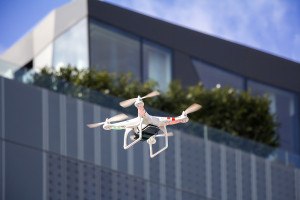Insurers’ use of drones to inspect property claims came into full swing in 2017, after the FAA began issuing permission allowing commercial firms to operate unmanned aerial vehicles in designated U.S. airspace.
 Nearly a year later, while some insurers remain in the testing phase of their aerial programs others have embraced UAVs as part of their adjusting toolkit.
Nearly a year later, while some insurers remain in the testing phase of their aerial programs others have embraced UAVs as part of their adjusting toolkit.
State Farm, the first insurer in the U.S. to receive FAA permission to operate unmanned aircraft for commercial use, has been testing drones since 2016. The insurer said a limited deployment of claims remote pilot teams was implemented in late August 2017 to conduct claim investigations. The team responds to large weather events that produce wind and hail damage.
Chubb uses drones for both catastrophes and standard property damage inspections, according to Erik G. Olsen, vice president and executive property specialist in Chubb’s Risk Engineering Services department.
“They [drones] enable us to quickly see more and gain access to properties more efficiently without putting inspectors in potentially dangerous situations,” he said.
About half the flights conducted by Chubb were to assist with post-catastrophe claims in the last quarter of 2017.
“Chubb’s risk engineering pilots helped claim teams assess damage over target locations for our clients,” Olson explained. “Chubb also deployed internal drone operators for claims assistance in flood ravaged neighborhoods where the company had personal lines clients. ”
Travelers uses drones for daily claims activity in addition to catastrophes.
Jim Wucherpfenning, vice president of property claims at Travelers, said that the company has expanded their drone program. As of last month, Travelers employs 550 FAA certified commercial drone pilots/claims adjusters.
With 17,000 flights across 48 states under its belt, he believes the insurer is the largest commercial user of drones in any industry in the U.S.
Some insurers using drones have reported shorter claim cycle times and improved customer service.
Travelers reported shortened roof damage claims cycle times.
“We’re continuing to see better results from a customer perspective. We’re able to inspect properties more quickly, get the estimates done more quickly and get a check or payment to the customer more quickly,” said Wucherpfenning.
State Farm said that one of its objectives is that by adding drones to its portfolio of claim processing tools, it will lead to greater claims efficiency and enhanced customer service.
Lessons Learned
Chubb’s drone use is expected to include more flights over targeted profile customer groups, said Olson, which are determined by predictive analytics.
“When we first started flying drones, we realized we could see a lot more detail on roofs to help detect and prevent water damage as a result of roof leaks and other deficiencies,” said Olson.
The insurer now routinely uses drones as a matter of course.
Drone use goes well beyond hail and wind claims, said Wucherpfenning. Travelers uses them for risk control and for oil and gas claims.
“We do use them for response to catastrophes. but we also use them for all other types of claims situations, both commercial and residential, as well as risk control,” Wucherpfenning said.
When it comes to incorporating drones into underwriting, risk management and claims there is a learning curve.
Chubb’s drone program has made the company more adept at harnessing the power of high resolution and thermal infrared (IR) imagery.
“One thing we have learned is that this process is neither quick nor easy, but it is extremely valuable,” said Olson. “We have to fly for inspections at certain times of the day to get the best imagery, especially for IR thermal results. We have a very short window to capture the best data and imagery to give us the most useful information. This takes a lot of coordination and planning for us and the client.”
He said the data assists the insurer in identifying potential causes of loss and offering risk engineering recommendations in a way that wasn’t possible previously.
“Drone imagery is powerful and not only helps identify exposures hidden to the bare eye, but also helps us achieve recommendations more efficiently,” said Olson. “As they say, ‘A picture is worth a thousand words.'”
Was this article valuable?
Here are more articles you may enjoy.


 Cyber Breach Affected 750,000 Canadian Investors, Regulator Says
Cyber Breach Affected 750,000 Canadian Investors, Regulator Says  NYC Sues Delivery App Over Lost Pay in New Mamdani Crackdown
NYC Sues Delivery App Over Lost Pay in New Mamdani Crackdown  Storm Goretti Batters Europe With Violent Winds, Power Cuts
Storm Goretti Batters Europe With Violent Winds, Power Cuts  OpenAI And Microsoft Sued Over Murder-Suicide Blamed on ChatGPT
OpenAI And Microsoft Sued Over Murder-Suicide Blamed on ChatGPT 